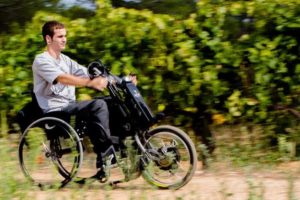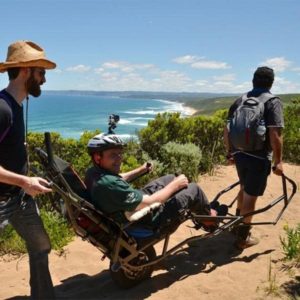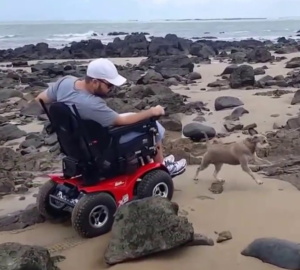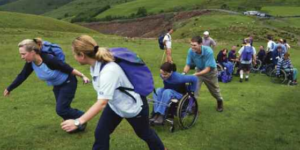What is bushwalking?
Bushwalking is different for everyone. The term ‘bushwalking’ is used in Australia to mean walking, pushing, hiking, tramping or adventuring out in nature in the Australian bush. It can be done for pleasure, challenge, experience, and for education. Bushwalking trips can have entirely different purposes: some are about going for a short stroll into a natural area with family and friends stopping for multiple coffee breaks, others are about travelling as far and fast as possible. Bushwalking encompasses everything from bird watching to looking at sunsets, to finding a nice swimming hole to go for a swim. Bushwalking is for everyone!
What information do I need for a bushwalk?
The two types of information that help bushwalkers decide on suitable bushwalking tracks include: 1. Track note information (what the track involves) and 2. Bushcraft information (general skills and information that help you enjoy bushwalking).
Track notes traditionally include:
- Navigation: directions like where to start and end, where to turn left and right, where there are river crossings or bridges
- Points of interest: where the look outs are etc.
Naturally Accessible Track notes also include:
- Barriers: This doesn’t mean a no-go zones or complete barriers, but details of challenges you might have to deal with in some way. Things like gates, fences, steps, rough bits of ground, steep areas.
- Facilities: resources that might help along the way that might help reduce the experience of disability. e.g. knowing information about seats along the track ( e.g. someone with arthritis or with a heart-lung condition, would find information about seats very handy if they need to rest often).
You can get more information on tracknotes from: http://www.naturallyaccessible.org/
Bushcraft skills around how to go bushwalking. For people starting out, the most frequently asked question is around what things to bring. For day walking, make sure to carry:
General day walking gear list
- Food and water: Bring food that’s easy to eat on the trail (muesli bars, fruit, snacks and crackers) – stuff that you normally eat and know won’t upset your stomach. Enough water to drink (2L a day) plus extra water to splash on your body so you don’t overheat.
- Gear:
-Gloves: makes long distances much more comfortable, helps when your push rims heat up and protects from rough gravel.
– A repair kit: What you would need if you got a flat tyre or if any major screws come loose. More on this below.
– Toileting equipment such as catheters (depending on your toileting needs). All-in-one catheters with integrated catheter and bag can be good especially on your first bushwalk so you don’t have to worry about carrying lots of different bits and pieces.
–Long-sleeved, lightweight collared shirt, sunscreen & hat: for sun protection
-Head torch: just in case you are out on the track longer than expected
-Rain jacket: keep yourself dry in case it rains
-Dry bag (or double plastic bags): keep your phone, or food, or other things, dry in case it rains.
-Thermal top, beanie: when weather is colder to keep yourself warm.
–First Aid Kit: band aids, enough personal medication.
–Personal locator beacon/ mobile phone: if there is mobile reception on the track, a mobile phone is ample
–Map & compass: for directions
You can get more information on bushcraft from: http://www.bushwalking101.org/
What types of adaptive equipment can I use to go bushwalking?
- FreewheelTM: Most cost effective adaptive equipment. It is small and easy to adapt to a regular manual wheelchair. The FreewheelTM attaches onto the footplate of a wheelchair and lifts your front casters off the ground so you can cruise across stones, leaves and sticks and increases your rolling resistance which saves your shoulders. FreewheelsTM can be more convenient than a separate piece of equipment such as a Mountain TrikeTM which can be big, cumbersome to get into a car.
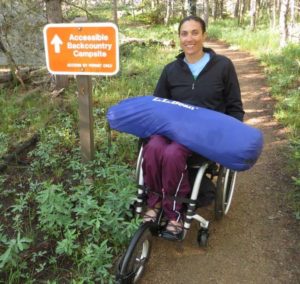
The FreewheelTM
- BatecTM: A electrally or hand pedal powered device which attaches to regular wheelchair with a couple of adaptations. You don’t need to use as much pushing strength. They are are expensive pieces of equipment but they have a lot of benefits. People using the Baytec can carry heavy supplies and attach backpacks, which can be helpful if you have got manual wheelchair pushers or bushwalkers with you.
Even if you can’t grip you still may be able to use the palm of your hand to control throttle and steering. There is an optional handcycle attachment that can work with or without power assist.
- TrailriderTM: An all-terrain wheelchair. National Parks and Wildlife Services provides TrailRider for visitors to hire for free at Kamay Botany Bay National Park, Dorrigo National Park and Kosciuszko National Park. For info on how to book them: http://www.nationalparks.nsw.gov.au/access-friendly/trail-rider
- All-Terrain powered wheelchair: Can be used on the beach, snow and also can be used on off-road trails and bushwalking trails. The All-Terrain powered wheelchair can navigate many steep and rough routes and can go up or down one or two steps with assistance. Especially a good for people who don’t have much upper body strength.
What’s the best way to provide assistance or get assistance?
Bushwalking tracks can be really long with steep up or down sections so sometimes it can be really helpful to have a bit of additional assistance.
A gentle push can be a great way to provide assistance, although over long distances this can uncomfortable for the person pushing.
An alternative option is ‘Huskying’, an adaptive technique where you attach a rope to the frame of your wheelchair, and you get a buddy or two who don’t use a wheelchair to pull you along from in front. You still have control of your chair and can still contribute a lot in terms of chair direction and extra power, but not busting your gut to do every inch of the trail. That helpful extra bit of oomph going uphills suddenly means you can enjoy so much more of what’s going on around you and enjoy watching out for wildlife.
What if the track is boggy?
After rain, it’s best to avoid tracks for a few days that are known to get boggy (The Narrabeen Lagoon trail is a good example). Having said that, if you come across an unexpectedly boggy, a great technique that you can use is ‘huskying’. ‘Huskying’ is where you attach rope to the frame of your wheelchair, and you get a buddy or two who don’t use a wheelchair to pull you along. Reducing tyre pressure on softer tracks can make pushing easier as the load is spread wider meaning the tyres do not dig in as far. However lower tyre pressure and increase drag on firm surfaces.
What about locked gates?
Gates are often installed at trailheads to keep out cars and motorbikes. Locked gates can be a significant barrier for a wheelchair user, but it’s worth considering some alternative options to navigate gates. Some locked gates have gaps large enough for people to “duck-under” while still blocking vehicle and motorbike access. Duck-unders are a good situation for people who can’t easily climb over a locked gate – and in this circumstance it’s good to know the dimensions of the duck-under option of the locked gate ahead of time to make sure your chair will fit.
Otherwise..
- Go around
- Go under
- Look for alternatives go far to the right or far to left
- If wire barrier, lift up and duck under
- Hop out of chair and bum shuffle under (if you’re comfortable getting in and out of your chair).
What’s the most likely repair that I would have to do on a bush walk?
A common repair that you’ll have to do on a bushwalk is for a punctured tyre. Getting a puncture when you’re out and about is annoying. That’s why it’s important to pack a puncture repair kit in case you get a puncture when you’re setting out for an adventure on a bush track. You can bring a repair kit to manage the risk of punctures.
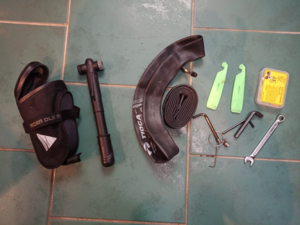
Picture of a typical repair kit for a wheelchair user
Things that should be in your puncture repair kit; pump (or CO2 canisters), 2 inner tubes, allen keys, puncture patches & repair glue, tyre levels, wrench). Worst case scenario, you can probably find a mountain bike rider and borrow their repair kit.
There’s no point bringing the repair kit if you don’t know how to use it, so practise at home beforehand! Be aware if someone else is carrying a repair kit, their spanners and screws might not match up with your chairs. Check over your chair before you go and make sure it is in good repair, bolts are tight, tyres have good tread and pressure.
What are a few good tracks to start with?
Three tracks to get started on:
- Fairfax Track: North Head. 30 mins, 760 m circuit easy.
- Narrabeen Lagoon: Northern Beaches. 2.5-3.5 hours, 8.6km circuit. Pretty easy but long
- Lady Carrington Drive: Royal National Park. 3.5 – 5 hrs, 9.7km one way. Hard, rough trail, steep sections. Good for once you have done a few longer walks and for practising huskying on.
For more tracks: http://www.naturallyaccessible.org/walks/
Who is involved?
National Parks Association of NSW (NPA) is a non-profit conservation advocacy group and NSW’s largest bushwalking club. Their mission is to protect and preserve natural places through advocating for better protection of natural places as well as helping more people get out and experience these special places. Despite the name, NPA does not manage national parks in NSW, that is the responsibility of the NSW Parks and Wildlife Service (NPWS) who has also partnered in this work.
In 2016, NPA secured funding from the Family and Community services to embark on the Naturally Accessible project, these grants have made the project possible.
Naturally Accessible is a project run by NPA in collaboration with Wildwalks, and NPWS, which aims to improve access for all by providing better bushwalking track notes, so more people can choose the right tracks for them. The project conducted research to better understand how to make bushwalking more accessible to older people and people with disability. Naturally Accessible has undertaken research, developed a framework and practical manual on how improve accessible for older people and people with disability to natural places.
Wildwalks is NSW’s most comprehensive online documentation of on-track walks. Owned by Matt McClelland, Wildwalks has a collection of around 1000 walks around NSW, particularly near Sydney. With funding from NPWS Wildwalks has documented over 50 walks using the naturally accessible framework.
Are there any walking groups?
Sargood on Collaroy, which is a luxury accessible accommodation for people with spinal cord injury, hosts ‘Bush Push’ activities. These are guided tours through the trails around their resort. Destinations include Narrabeen Lakes, West Head Lookout, Warriewood Wetlands, Deep Creek Reserve, Middle Head Army Barracks. You can join in if you have Sargood membership or if you are staying at the resort. You get access to their Batecs, X8 Wheelchairs and Freewheels if you join them on Bush Push. For more information: http://sargoodoncollaroy.com/stay/recreational-activities/#program
The National Parks Association of NSW is aiming to make some of their bushwalking program open to people with a diverse range of abilities. Watch this space at https://npansw.org/bushwalking/ and http://www.naturallyaccessible.org/
Naturally Accessible is supported by funding from the Department of Family and Community Services (FACS).
